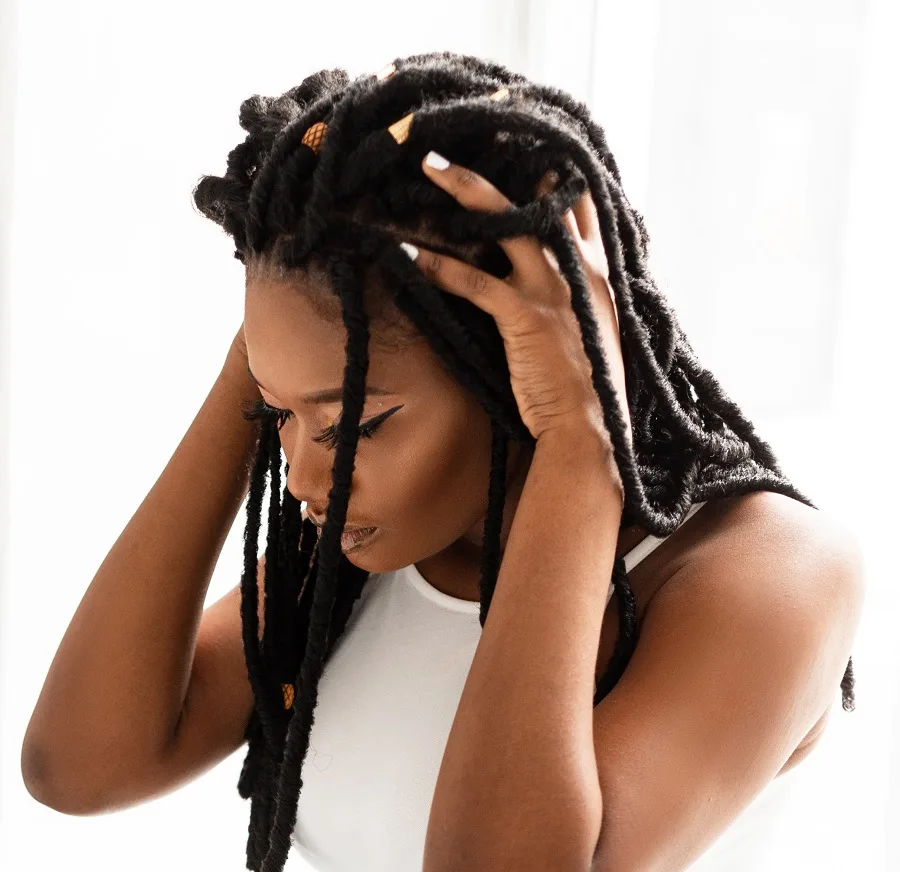One of the most alarming things about dreadlocks is… dread-lost. Hair falling is always awful to deal with, but when a big group of hairs is about to fall, and you can see with your own eyes that it is going to happen sooner and sooner, that can be a nightmare.
Therefore, if dreads thinning at the root worry you, you must be aware of why it can happen, so that you can prevent it, and if the problem has already started, check how to fix it right now, right here.
How to Tell If Your Dreads Are Thinning at Root?

Take one of your dreads separately, look at its root, and see if there are only a few tiny hairs that hold that dreadlock or if there’s a strong base. Check more of them. Start panicking yourself. No, don’t do that, but if dreads are thinning at the root, you’ll see or feel that easily, and you’ll need to know what to do, or how to avoid getting there if there’s no problem yet.
So, let’s jump right to the root of the problems, aka the causes, and check if you behave well with your dreads or if you need to change your lifestyle.
What Causes Dreads to Thin at The Roots?
There are many reasons, even opposite ones, for dreads to thin at the roots. Hair and causes might be different from one another, but we’ll explore the most common ones:
Unpropper Cleaning

Washing dreadlocks is a different thing, compared to washing hair before locking it.
Doing it too often would make your dreads have no time to stay dry and breathe. Plus, when the hair is wet, it is the most sensitive and exposed to breakage, and dreadlocks are pretty heavy when getting all the water in.
Washing them too rarely would cause accumulating build-ups, which would not be very funny as well, and it would block your new hair growth. Also, using heavy products, or products that aren’t water-soluble, leads to the same thing.
Unpropper Drying
Don’t sleep with your dreads wet, unless you’re sleeping under your hair blower, or on a sunny beach. Keeping humidity inside your dreads would cause mold, dread-rot, and even baldness.
Unpropper Maintaining
If you do your maintenance too often, you can fail by making your dreads tensed, which can lead to hair breakage and hair loss, and if you’re not doing it when necessary, the base wouldn’t be in its best shape to hold the dreads, which become heavier in time because all the hair that falls will remain there.
The new growth must help to hold the dreads too.
Unpropper Styling

Wearing hairstyles that frequently pull your dreads hard away, would cause hair loss, and eventually traction alopecia.
Unpropper diet
Hair condition is also determined by inside nutrients, and having a lack of them would make your hair grow thinner, weaker, fragile, or… less.
Sadly, our systems also get weaker with aging. Also, avoid stress – it is the most often cause of hair loss, and dreadlocks only work on relaxed people.
Weight
No, not your weight, the weight of your dreadlocks. If dreadlocks grow long, they would weigh a lot, and if your hair isn’t particularly strong, it will be very hard for it to hold that weight, so the root would give up.
How to Fix Dreads Thinning at Root
First of all, if you need to fix your thin roots, the best way is to identify the causes of thinning and change your bad habits, so your hair would grow healthy and strong, and your dreads would have the best support.
If the base is loosened, and you also have new growth, maybe it is time for you to go for a touch-up. It is important to keep the original sections of your dreads and don’t let them bind together unless you’re up for a freeform experience or you intend to bind some thin locks together for the purpose of making thicker ones.
If you need a quick solution, you can add hair wherever you need to thicken your dreads, except right on the scalp. However, you can use some color and fake it. There are plenty of products on the market for coloring your scalp in order to look full. But, remember, your dreads can still fall that way, so it is good to do something about it.
How to Prevent Dreadlocks from Thinning at the Root

If you want to prevent your dreadlocks from thinning at the root or improve your hair growth and your dreads condition, start properly taking care of your dreads.
- Wash your dreadlocks regularly and gently, using low-weight, natural, and suitable for your hair-type products. Don’t use a big amount of product and make sure you rinse it well.
- Always completely dry your locks before sleeping. Use a satin bonnet to prevent breakage.
- Nourish your scalp with oils promoting hair growth, and use water-based moisturizers.
- Avoid thigh stylings, or pulling your dreads away hard.
- Keep your original sections and incorporate the new growth into the right dreads. Always go to a professional for doing this. Don’t make them too tense.
- Make sure you take enough vitamins, minerals, and proteins in your diet or use food supplements.
- Trim your dreads if they weigh too much.
So, What to Do About The Dreads Thinning at The Roots?
The best thing you can do to help your dreads grow thicker is to offer them the proper condition to regenerate and stay strong.
That includes washing, drying, maintaining, and nourishing as much as needed, using suitable products, and also having a healthy lifestyle, eating well, sleeping with a satin bonnet, and avoiding stress.
FAQs
If you don’t get any touch-ups for more than 3 months, it is normal, as the base gets loosened. In this case, you only need to call your stylist.
Usually, it is possible, but for a long-term result, it involves patience and promoting healthy hair growth.
In some cases, it can lead to that, but the sooner the measures are taken, the more chances there are for the situation to be remedied.
